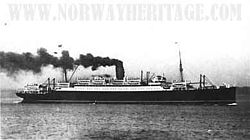RMS Antonia
|
||||||||||||||||||||||
|
||||||||||||||||||||||
|
||||||||||||||||||||||
|
||||||||||||||||||||||
|
||||||||||||||||||||||
The RMS Antonia was an ocean liner of the British shipping company Cunard Line that was put into service in 1922 and was used in passenger and mail traffic between Great Britain and the USA . In 1942 the ship was sold to the British Admiralty and renamed Wayland .
The ship
Laid down in 1920, the ship, which had a tonnage of 13,867 GRT, was shipped to the Vickers LTd shipyard . built in Barrow-in-Furness , where it was launched on March 11, 1921. The 158.46 meter long and 19.90 meter wide passenger and mail ship had a chimney, two masts and two propellers and was powered by steam turbines that made 8,500 SHP and allowed a top speed of 15 knots. The ship could carry 500 passengers in the cabin class and 1200 in the third class. The RMS Antonia was one of six sister ships of the "A" class that the Cunard Line put into service in the first half of the 1920s. The others were the RMS Ausonia (II), the RMS Andania (II), the RMS Aurania (III), the RMS Ascania (II) and the RMS Alaunia (II).
The Antonia was completed in December 1921 and left London on June 15, 1922 on her maiden voyage to Quebec and Montreal . In January 1923 a fire broke out on board on the way from Hamburg to New York . It could be deleted. Another incident occurred when the ship was involved in a collision with the Norwegian ship Brio on September 27, 1929 in Liverpool . The collision went smoothly, however, so that the Antonia was able to continue her journey undisturbed. On October 3rd, 1934, she answered the distress signals from a small British necklace that got into trouble about 500 miles from St.John's ( Newfoundland ). The Antonia stayed with the ship until it was repaired.
Second World War
The Second World War began with the German invasion of Poland when the Antonia was just on her way to Montreal. It was called back to Liverpool by the British government to be converted into a troop ship. In the first year of the war she brought Canadian troops to Great Britain and emigrants to Canada and the USA . But in 1940 the Admiralty converted it into a workshop ship, which took 10 months. The Admiralty bought the Antonia, which was renamed HMS Wayland on August 19, 1942 . After some time as a workshop ship, the HMS Wayland drove to Ceylon in a convoy . In May 1943 her task changed and she went to Tunisia, where she supported the Axis on their campaigns against Italy and Tunisia for the rest of the year. In 1944 she was used again as a workshop ship. From Ceylon, she supported the Far East fleet on their campaigns against Japan.
After the war
After the war, the HMS Wayland was completely overhauled in Bombay and began its journey home to Great Britain in February 1946. Due to technical difficulties, however, it did not arrive there until a month and a half later. The former RMS Antonia was scrapped in Troon ( Scotland ) in 1948 .
Regular scheduled services
The normal route ran from London to Montreal (only to Halifax in winter ). The ship also called regularly in Hamburg . From April 1934, Cobh also joined the regular route.
